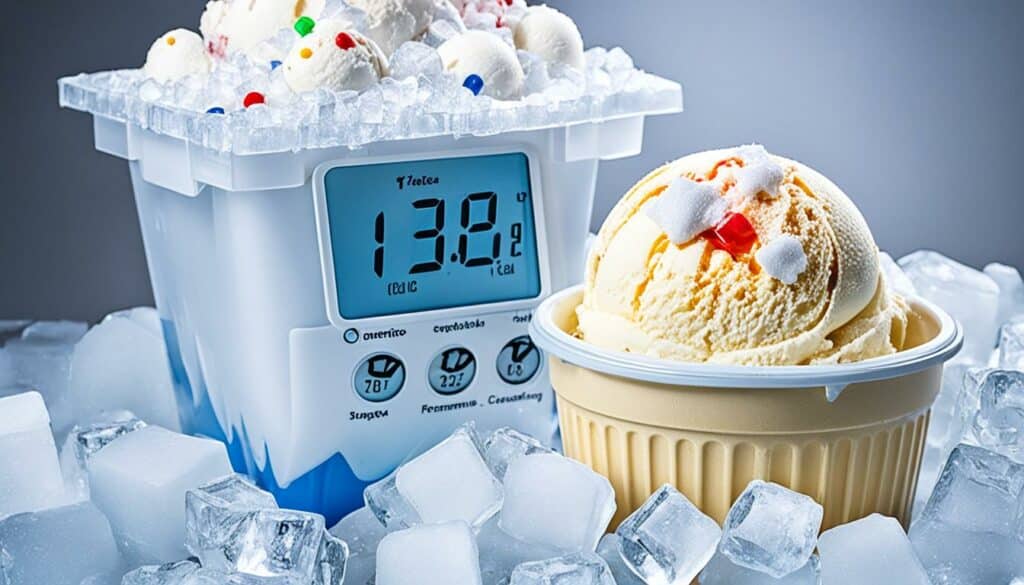Ice cream is a delicious and refreshing dessert that many people love. However, it’s easy to forget about a container of ice cream in the freezer, leaving you wondering if it’s still safe to eat. In this section, we will explore how long ice cream lasts in the freezer and the factors that contribute to its shelf life.
- The typical shelf life of ice cream in the freezer
- The optimal storage conditions for extending the freshness of ice cream
- The common factors that impact the freezer life of ice cream
Key Takeaways
- Ice cream can have a shelf life of several months in the freezer, depending on the storage conditions and ingredients.
- Temperature fluctuations, exposure to air, and other environmental conditions can impact the longevity of ice cream in the freezer.
- By following proper storage techniques and paying attention to signs of spoilage, you can enjoy your favorite ice cream for longer periods.
Understanding Ice Cream Freezer Storage
Storing your ice cream correctly is crucial to maintaining its quality and flavor. The optimal storage conditions for ice cream in the freezer are essential for preserving the product’s texture, flavor, and shelf life.
The ideal temperature for ice cream freezer storage is between -5°F (-20°C) and 0°F (-18°C). Maintaining a consistent temperature in your freezer is essential to keep your ice cream at the proper temperature and texture. Fluctuations in temperature can cause the ice cream to develop ice crystals or degrade its quality.
When it comes to container options for ice cream freezer storage, select a container that is freezer-safe and airtight. Avoid storing ice cream in a cardboard container, as it can absorb odors from the freezer and affect the flavor of the ice cream. You can store ice cream in a reusable plastic container or airtight container with a lid.
To preserve the quality of your ice cream even further, try placing a piece of plastic wrap directly on the ice cream’s surface before sealing the container. This strategy can prevent ice crystals from forming and prolong the ice cream’s shelf life.
Pro tip: Before freezing your ice cream, make sure it has hardened in the refrigerator for at least two hours. This process results in a firmer texture, which is better suited for storage in the freezer.
| Storage Condition | Optimal Temperature Range | Recommended Container Type |
|---|---|---|
| Freezer Temperature | -5°F (-20°C) to 0°F (-18°C) | Freezer-safe, airtight container |
| Storage Time | 1-2 months | Reusable plastic container or airtight container with a lid |
| Before Serving | Let sit at room temperature for a few minutes to soften | N/A |
By following these simple steps, you can ensure your ice cream stays fresh and delicious in the freezer for a prolonged period. In the next section, we will discuss the expected shelf life of ice cream in the freezer and factors that can impact its longevity.
Shelf Life of Ice Cream in the Freezer
Did you know that the shelf life of ice cream in the freezer depends on various factors? The quality and shelf life of ice cream can be affected by its ingredients, manufacturing process, and storage conditions.
The average shelf life of ice cream in the freezer is between two and four months. However, you can prolong its freshness by storing it in optimal conditions. One of the key factors that influences the shelf life of ice cream is the temperature at which it is stored.
The ideal temperature for storing ice cream is around -20°C (-4°F), as temperatures that are too high can cause the product to spoil.

Another important consideration for extending ice cream’s shelf life is the container in which it is stored. Choosing an airtight container can prevent moisture and air from seeping in, which can cause freezer burn and affect the texture and flavor of the ice cream.
In summary, to prolong the shelf life of ice cream in the freezer, follow these key storage tips:
- Store at -20°C (-4°F)
- Use an airtight container
- Avoid exposing it to temperature fluctuations
By following these tips, you can enjoy your favorite frozen treat for longer and avoid any unpleasant surprises when it comes to the quality of your ice cream.
Tips for Extending Ice Cream’s Freezer Life
Ice cream is a favorite treat for many, and nothing ruins the experience like finding that your dessert has lost its flavor or creamy texture. By taking some simple measures, you can extend the shelf life of your ice cream, preserving it for longer and keeping it fresh. Here are some tips to help.
1. Choose the Right Container
The right container can make all the difference in preserving the quality of your ice cream. Plastic or glass containers with tight-fitting lids are ideal for storing ice cream. Avoid containers with too much headspace or open tops to prevent ice crystals and freezer burn. If you’re looking for a more eco-friendly option, reusable silicone containers work well too.
2. Freeze at Optimal Temperature
Freezing ice cream at the right temperature is crucial for preserving its quality. Keep your freezer at 0°F (-18°C) for optimal storage conditions. If your freezer temperature is too high, it can cause ice crystals to form and affect the texture.

Pro Tip: For best results, place your ice cream in the back of the freezer, where the temperature is most consistent.
3. Wrap It Up
Wrapping your ice cream container with plastic wrap or aluminum foil can help prevent freezer burn. Make sure to press the wrap firmly against the surface of the ice cream to avoid air exposure. Another option is to place the container inside a plastic freezer bag, squeezing out as much air as possible before sealing it.
4. Use Stabilizers
Stabilizers such as carrageenan, guar gum, and xanthan gum can help prevent ice crystals from forming in your ice cream. These additives are commonly found in commercial ice cream and can be purchased at specialty food stores. Follow package directions for recommended ratios.
5. Thaw Slowly
When it comes time to enjoy your ice cream, be sure to thaw it slowly. Rapid temperature changes can cause ice crystals to form, affecting the texture of your treat. Transfer the container to the refrigerator for 10-15 minutes before scooping, or leave it out at room temperature for 5-10 minutes.
By following these tips, you can extend the life of your ice cream in the freezer without sacrificing flavor or texture. Try out these tricks and enjoy your favorite frozen indulgence for longer periods.
Factors That Impact Ice Cream’s Freezer Life
When it comes to preserving the quality of ice cream in the freezer, various factors come into play.
One of the most critical factors is temperature fluctuations. If the freezer temperature is inconsistent, such as when the appliance door is frequently opened and closed, the ice cream can develop ice crystals, lose its smooth texture, and deteriorate in flavor over time.
Another vital factor to consider is exposure to air. When ice cream is exposed to air, it can become oxidized, resulting in a loss of flavor quality. Proper container storage, such as airtight containers, can help mitigate this issue.
Additionally, the presence of other odors or flavors in the freezer can alter the taste of ice cream. It’s essential to store ice cream away from strong-smelling items, such as garlic or onions, to prevent cross-contamination.
Here’s a helpful table showcasing the various factors that can impact ice cream’s freezer life:
| Factors | Impact |
|---|---|
| Temperature fluctuations | Can develop ice crystals, diminish texture, and affect taste quality. |
| Exposure to air | Can result in faster oxidation and flavor loss. |
| Presence of other odors or flavors | Can alter the taste of ice cream. |
By understanding these factors and taking steps to mitigate them, you can ensure your ice cream lasts longer in the freezer without compromising its quality.
How to Tell If Ice Cream Has Gone Bad
Ice cream is a tasty and beloved treat that many people enjoy year-round. However, sometimes it’s hard to tell if your ice cream is still good to eat or if it’s gone bad due to prolonged storage. Here are some signs to look out for:
- Texture changes: If the ice cream has become icy, grainy, or has large ice crystals, it may not be safe to eat.
- Off-flavors: If the ice cream has a sour, bitter, or metallic taste, it may be a sign that it has spoiled.
- Visual cues: If there is discoloration or mold growing on the surface of the ice cream, you should discard it.
If you are unsure whether your ice cream is still safe to eat, it’s better to err on the side of caution and discard it. Eating spoiled ice cream could lead to foodborne illness, which no one wants to experience.
“Remember, when in doubt, throw it out.”
Preventing ice cream from going bad in the first place is the best course of action. Make sure to always store ice cream according to the instructions on the container and avoid exposing it to fluctuating temperatures. With proper storage and regular checks, you can ensure that your ice cream stays fresh and delicious for as long as possible.
Reviving Frozen Ice Cream
Nothing is worse than craving a scoop of ice cream, but finding it rock hard in the freezer. Fortunately, reviving frozen ice cream is possible with a few simple techniques.
Let it Thaw
One of the easiest ways to soften up your ice cream is to let it sit at room temperature for a few minutes. This allows it to thaw and become more scoopable. However, be careful not to leave it out for too long, as it can lead to melting and refreezing, resulting in icy, grainy ice cream.
Microwave
If you need to soften your ice cream quickly, try microwaving it for 10 to 15 seconds. Be sure to remove it from the container first and place it in a microwave-safe dish. Be careful not to overheat it, as this can cause it to melt unevenly.
Add Dairy
If your ice cream is extremely hard, try adding a bit of milk or cream to it. This helps to break down the ice crystals and make it easier to scoop. Simply add a tablespoon or two of dairy to your ice cream and stir until it reaches the desired consistency.
“Softening up rock-hard ice cream can be a challenge, but with these tips, you’ll be able to enjoy a bowl of creamy ice cream in no time!”
Conclusion
As we’ve explored in this article, the longevity of ice cream in the freezer depends on several factors, including storage conditions and ingredients. By storing your ice cream at the right temperature and using proper packaging techniques, you can prolong its shelf life and maintain its flavor and texture.
It’s important to pay attention to signs of spoilage, as consuming expired ice cream can pose health risks. If you notice any off-flavors or changes in texture, it’s best to discard the container.
Finally, don’t despair if you find your ice cream a bit too frozen. With the right techniques, you can revive it to its former creamy glory.
By following the tips and strategies outlined in this article, you’ll be well on your way to enjoying your favorite frozen treat for longer periods. Happy scooping!
https://thinkgirl.net/green-tea-ice-cream/
FAQ
How long does ice cream last in the freezer?
The shelf life of ice cream in the freezer can vary depending on several factors, including the ingredients used and the storage conditions. Generally, ice cream can last for about 2-3 months in the freezer before it starts to lose its quality. To ensure the best taste and texture, it’s recommended to consume it within this timeframe.
What are the best practices for storing ice cream in the freezer?
To store ice cream in the freezer properly, it’s essential to keep it at a consistent temperature of -18°C (0°F) or lower. Additionally, opt for airtight containers to prevent air and moisture from affecting the ice cream’s texture. Avoid storing ice cream in the freezer door to minimize temperature fluctuations.
How does the shelf life of ice cream in the freezer get prolonged?
You can prolong the shelf life of ice cream in the freezer by following a few simple steps. Firstly, make sure the lid of the container is tightly sealed to prevent air from entering. Secondly, store the ice cream at the back of the freezer, where it is coldest. Lastly, avoid repeatedly opening and closing the freezer door unnecessarily to maintain a constant temperature inside.
What are the optimal storage conditions for ice cream?
The optimal storage conditions for ice cream include keeping it at a constant temperature below -18°C (0°F) without temperature fluctuations. It is also essential to store ice cream in airtight containers to prevent any exposure to air or moisture. These conditions help maintain the taste, texture, and quality of the ice cream for a longer period.
What factors can impact the freezer life of ice cream?
Several factors can impact how long ice cream lasts in the freezer. Fluctuations in temperature, exposure to air, and the quality of the ingredients used can all affect the freezer life of ice cream. Additionally, improper storage, such as leaving the lid partially open or storing ice cream in the freezer door, can also shorten its shelf life.
How can I tell if ice cream has gone bad?
There are a few signs to look out for to determine if ice cream has gone bad. Visual cues, such as ice crystals or freezer burn, can indicate spoilage. Changes in texture, such as becoming excessively icy or grainy, can also be a sign. Off-flavors or a sour smell are additional indicators that the ice cream has gone bad and should be discarded.
What can I do to revive frozen ice cream?
If you have encountered rock-hard ice cream in the freezer, there are a few techniques to soften and revive it. One method is to place the container in the refrigerator for about 15-20 minutes before serving. Alternatively, you can use a warmed ice cream scoop to break through the frozen surface. It’s important to avoid using the microwave to thaw ice cream, as it can cause uneven softening and affect the texture.
How can I keep my ice cream fresh in the freezer?
To keep your ice cream fresh in the freezer, it is crucial to store it in airtight containers, avoiding any exposure to air. Additionally, make sure the freezer temperature is consistently maintained below -18°C (0°F) to prevent any degradation of the ice cream’s quality. Regularly inspect the ice cream for signs of spoilage and discard any containers that show indications of being past their prime.








